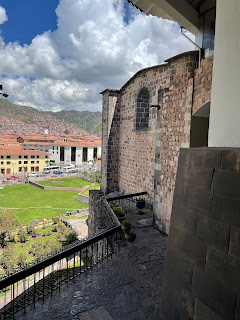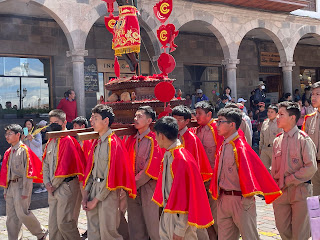 |
Statue at the center of the Plaza de Armas
(funny that today was supposed to be cloudy and rainy!) |
I am finally getting my energy back and getting rid of my headache! Altitude sickness is no fun, but for some people it is dangerous and for others it severely disrupts travel plans, so I am thankful that it was mild. I had read that it often takes three days and today was day three in cusco, so! I was out all day, did not need to come back to the hotel for a mid-day siesta! My doc had suggested using my inhaler before needing it (prophylactic use), so I did that today and no chest pain or tightness. Yay! Not to say that I wasn't a bit winded at the top of some of those hills, but I noticed other people were also breathing hard. After breakfast and reloading my backpack, I was off. My plan was first to go to Qorikancha (I believe it is pronounced core-i-can-cha)--an Incan version of the Spanish name, and perhaps the Inca museum and cathedral. Also, today is supposed to be the El Señor de los Temblores procession--I believe it is in the afternoon. Lots of pics today everyone, hold on!
First stop, Qorikancha. I had walked right by it so many times and not realized what it was! It is a short walk from my hotel with benches along the street facing the gardens. I had even sat on the benches a few times and looked at the gardens--even had walked around the other side of it. Well, anyway, I went in and paid my entrance fee. You are not allowed to take pictures of the paintings and artwork, but can take pictures elsewhere. Qorikancha was an Incan temple built in the mid-15th century. The center area had a gigantic sun-head covered in gold facing the east so that it glowed when the sun would shine on it in the morning. The walls of the center courtyard (The Temple of the Sun) were supposedly covered in 700 sheets of solid gold with life-sized golden statues of animals and agricultural products as well. When the Spaniards invaded, they took all of the precious metals and melted them down. The central courtyard is now surrounded by cloisters from the Spaniards who invaded and gave it to the Dominican monks. To each side of the central courtyard are Incan chambers. The largest are dedicated one to the moon (wife of the sun) and one to the stars--these two were originally covered in silver, then one to the rainbow god, and one to the thunder god. The site was also an observatory where high priests monitored celestial activities. Some of the stonework is original Incan stonework, some is reconstructed in the same same stone the Incans used, and some is colonial (Spanish). The Spaniards covered some of the Incan stonework with plaster and then painted murals over it. Qorikancha was the center of the Incan world. It is the starting point of the Incan stone road system that formed the road system of the entire Incan empire. Imaginary lines (Seqes) leading out from Qorikancha also connected a system of 328 sacred sites (or wakas) around Cusco--it makes me think of the ley lines that connect many other sacred spaces such as stone circles.
 |
| Model of the original complex and grounds |
 |
| The central courtyard |
 |
| The grounds--also used for ceremonial purposes |
 |
| One of the colonial doorways |
 |
| Central courtyard from above |
 |
| The chambers of the rainbow and thunder from above |
 |
| Chambers of moon from above |
 |
| Explaining the seqes and wakas |
 |
| an artist's interpretation of the seqes connecting the wakas |
 |
| The orginal Incan wall--notice the curve? |
 |
| More of the Incan wall |
 |
| The central courtyard |
 |
| A model of Qorikancha from the Inca Museum |
After the very interesting Qorikancha, I walked toward the Plaza de Armas to go to the Cathedral. As I approached, there were people everywhere! I heard a band, saw large numbers of police officers, people in uniforms, etc. I wondered if it was the procession for the El Señor de los Temblores celebration, even though it was only 11:00 and the procession was supposed to be in the afternoon (although I wasn't sure at what time in the afternoon). I saw the band parading around the plaza and what looked like it could be the statue of the saint above the crowd. So I hurried over, saw the band made up of boys, more boys in uniform, and others. There was also the El Señor de los Temblores' crucifix of the savior being carried on the shoulders of some young men with a priest (or acolyte) in front of it waving incense. The crucifix is blackened by soot, but is considered to the be patron saint of Cusco, responsible for saving the city from further earthquake damage. It dates to the earthquake of 1650 and the procession always takes place on Holy Monday, the day after Palm Sunday which begins Holy week, which is the week before Easter.
 |
| boys marching |
 |
| the crucifix |
 |
| the band |
 |
You can see them pinning their music to the back of the
person in front of them! |
 |
| Other dignitaries |
 |
| the procession leaving the plaza area |
 |
| more boys |
As I was walking through the plaza, I saw a line of police in front of the cathedral that I had been planning to visit. I saw that people were able to go through, so I did too. Inside was a crown of people, with church organ and a choir singing so I went closer. There was a service going on and when I looked, the crucifix was there being blessed and prayed to. Perhaps the one I saw just leave the plaza was a different one. This one had colored lights on it and was quite the spectacle. I wasn't going to take a picture because it was a religious ceremony, but I saw many other people taking pictures and filming it, so I waited until there was music (not prayer) and took a picture. I walked around inside a little (since I didn't have to pay for entrance). During the peace, when you greet and shake hands with your neighbors, a few women near me shook my hand and one grasped my arm, so I returned the greetings.
 |
| The cathedral with a line of police |
 |
| the religious service, with clouds of incense |
After this, I went up a hill away from the plaza to the Inca Museum. It doesn't look like much, but it will surprise you. It begins with all of the other peoples that lived in the region before the Incas, starting around 16,000 BCE. It talks about each tribe with great detail and with many pieces of pottery and weapons and a few statues and photos of cave paintings. They were a very pastoral, peace-loving people, until the Incas attacked them and took over. The Incas established their capital in Cusco in the 12th century, then began their conquests in the early 15th century and within 100 years had gained control of and Andean population of about 12 million people. The artifacts of the Incas were, indeed, much advanced. Then, of course, the Spaniards invaded and took over, beginning the colonial era. After a few uprisings, the Inca people were not allowed to wear their traditional clothing, use their traditional musical instruments, or practice their religion. They had to look and act like Spaniards.
 |
| The courtyard of the museum |
 |
| from a pre-Incan tribe |
 |
| Cave painting 5000 BCE |
 |
| Miniature sculptures made in Turquoise 750 CE |
 |
| Close-up of some of the miniatures |
 |
| The mythological origin story of the Incas |
 |
| Terraced farming pre-Inca |
 |
| Terraced farming pre-Inca |
 |
| Incan cooking oven--fire is inside and pots are placed in holes on top |
 |
| the Hiram Bingham era of excavating Machu Picchu |
 |
| The excavation |
 |
| A block from the site |
 |
| The stones on the right were used to hold up roofs, the stones on the left were hinges |
 |
| A model of Machu Picchu |
 |
A book, written in 1609 by a Spaniard, about the great civilization
of the Incas; this book inspired the anticolonial movements of the 18th and 19th centuries |
 |
| a detail in the museum building |
 |
| stone designs in. the courtyard |
 |
The courtyard of the museum
|
After seeing the museum, I headed back to the Plaza where people were gathering near the Cathedral and there was a stronger police and military presence. News trucks were set up, so I snatched a piece of curb and waited about 2 hours for something to happen. There were people walking back and forth hawking drinks, food, little paper hats and umbrellas to protect from the sun, stools to sit on and the little ears of corn made by weaving palm leaves. The crowd filled in, and old lady asked for a piece of curb next to me, so I moved over. I bought a bottle of water from the hawkers. Groups were marching into the cathedral. At one point, a group of men with traditional shirts and shell horns lined up and blew those several times. A band was setting up. Eventually, the El Señor de los Temblores crucifix appeared in a cloud of incense through the doors of the cathedral to the blowing of the shell horns, and the band playing, and someone speaking into a microphone. It was moved to face all the different directions of people surrounding the cathedral porch. Some people knelt on the ground, some genuflected to it. It was moved back and forth, then set off with the many groups following it. By this time, most of the crowd was leaving, so I did too. I had to find an ATM for cash for my tour tomorrow (we are responsible for one of the meals), a market for 2 bottles of water, and I stopped in a pharmacy to buy a razor to shave my legs (!) before I wear capris in Lima--I forgot my razor. Then I found a restaurant to eat. A barbecued pollo meat on ciabatta roll sandwich served with french fries. When I first sat down they gave me a tiny bowl of potato chips and a tiny bowl of (I think) guacamole to dip--it was good. A lot of wandering to find the restuarant--it was called Sepia. The wait staff had excellent English and tolerated the little bit of Spanish I've learned from DuoLingo.
 |
| A school established in the 1650s. (children were playing outside when I went by) |
 |
| Shell horn blowers |
 |
| the appearance of the crucifix |
I won't have a blog post tomorrow because I will be gone on an overnight tour to the Sacred Valley and Machu Picchu. I'll share when I get back on Wednesday or Thursday (depending on how late it is and how tired I am when I get back!).

















































No comments:
Post a Comment